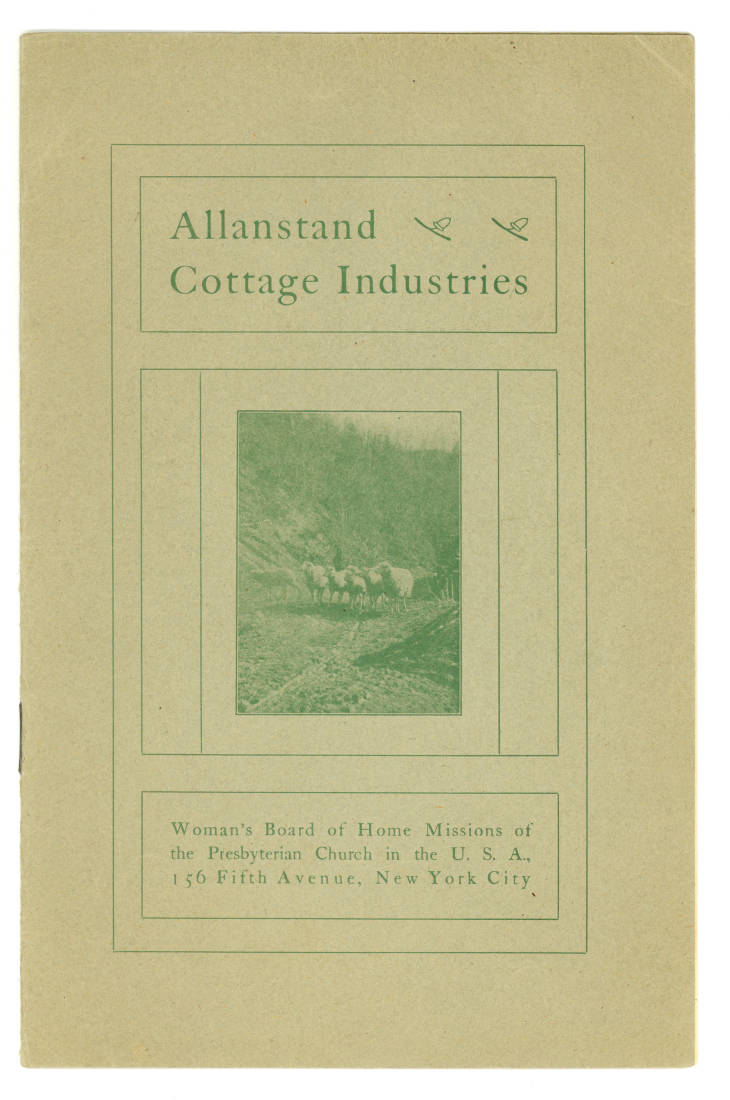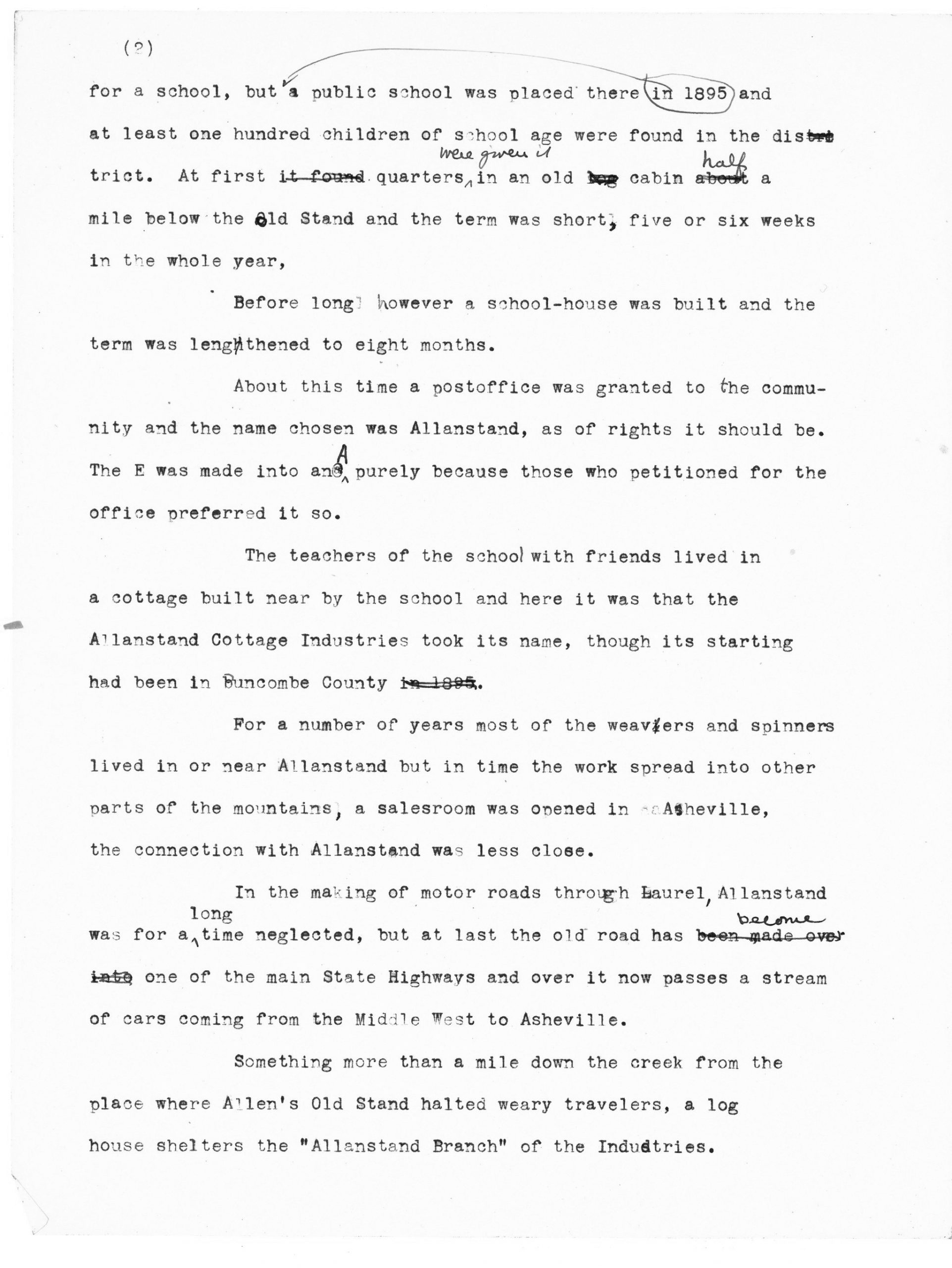The History of America’s Oldest Craft Shop
The history of
Allanstand Cottage Industries, Est. 1895
In those days, the rest of the country was taking steps toward industrialization. An increasing number of goods were available in wide distribution from mills and factories. Family farms began to decrease. Especially affected were the rural mountain communities that had depended on farming and handmade goods. The lure of industrialization led many away to mines, logging industries, and Piedmont mill towns, where wages were paid to buy commercial goods. Fractured by this shift, mountain communities were no longer as self-sustaining. Store bought goods such as clothes, linens, furniture, and dishes were preferred over their handmade equivalents for their variety, uniformity, and their symbol of middle class status. Money for these goods was scarce in Appalachia, as the rough mountain terrain discouraged the development of commercial trade. Where money was scarce, schools, churches, and medical facilities were also scarce or substandard compared to America’s growing middle class. Southern Appalachia was regarded as impoverished and pursued by churches as a prime place for missionary and social work. Frances Goodrich had come to the neglected mountains of North Carolina to bring about what was missing, but on her journey, found herself amidst the resources of a unique culture.
In Brittain’s Cove, Miss Goodrich did more than teach the school children. All aspects of the Dulah Springs community became engaged by her vision and organization. With the school mothers, she conducted regular “sewing and chatting” sessions. Women brought their mending and casually discussed “the resources at hand for bringing healthful excitement” to the tedium of tough mountain life.
She took the idea to the mothers, only to find they were all inexperienced in the weaving arts. It seemed the old craft was gone from the cove. After consulting together, however, the mothers began to recall the whereabouts of an old loom and an elder who still knew how to use it. Under Goodrich’s direction, the women of Brittain’s Cove produced three coverlets from native raw materials that they dyed, carded, spun and wove using patterns (drafts) found stored in closets. A craft revival began to stir.
Goodrich spent three more years in Brittain’s Cove, rediscovering with her neighbors the dying art that had once been a routine necessity in every community. As her social work increased, so did her interest in handicrafts. In her continued acquaintance with the region, she observed that people in the upper reaches of Madison County wore bright hand-woven “Lindsey” clothing. Her delight in finding hand weaving still practiced there prompted a move to her next missionary post in 1897. While in the Little Laurel river area in Madison County, she found “more of the thrifty, old time ways had been kept.”
Just across the state line in Flag Pond, Tennessee, she met the expert weaver, Elmeda Walker, who had “woven more webs than she could count” for trade. Goodrich chose this venerable old woman to set the standard for the women of the Laurel area who, through Goodrich’s encouragement, were eager to “save the old art from extinction.” The women became specialized for the tasks of dyeing, carding, spinning, and weaving to fill the growing orders for coverlets Miss Goodrich received. The women were paid on a piecework basis. A weaver made 35 cents per yard of cloth. Those who carded and spun got 33½ cents per pound of wool and 44 cents per pound of cotton.
There were no outlets for commerce in her new surroundings besides an old log structure known as “Allen’s Old Stand.” Years earlier, Mr. Allen had built lodging for drovers leading herds of livestock through the mountains from Tennessee to South Carolina. “Allen’s Stand” was out of use, but the name remained, and Goodrich adopted both the name and the logs from the building to start her new weaving industry in 1902. Allanstand Cottage Industries sold directly to passers-by at the cottage, but the bulk of the business was from mail order brochures distributed through the Presbyterian mission. Customers could send raw materials with requests for a variety of patterns or colors. Soon more local people brought their handicrafts to Allanstand to market their wares. Goodrich would closely examine the workmanship of each prospect, giving recommendations to increase the work’s value in the market. When the workmanship met her approval, she would put them in business. The growing inventory included such practical items as baskets, quilts, wooden furniture, brooms, and even made-to-order hooked rugs. In this manner, mountain farmers and sharecroppers were not as vulnerable to recruitment from the mills. They worked on their craft during spare hours on the farm, supplementing an otherwise sparse income.
Goodrich had a three-fold purpose in mind for her Cottage Industries:
- To bring money to women working in homes and communities too far from the markets.
- To give these women the pleasure of producing beautiful things.
- To save the old time crafts from extinction.
In just a few years, the inspired Goodrich raised enough money through the mission for a day school, church, and a post office in Allanstand, while her business thrived along the Little Laurel. The church, school, and post office are now obsolete, but the hamlet still bears the name “Allanstand.” The original buildings remain along Rt. 208 beside a marker commemorating Allanstand Craft Shop’s first home.
It was the construction of a new road between South Carolina and Tennessee that permanently changed Allanstand, both the town and the shop. No one traveled the old road anymore, so in 1908, Goodrich opened a salesroom at 102 S. Main Street (now Haywood Street) in Asheville, NC. The weaving cabin was still used, and the original shop still operated a few more years under the management of Annie Gosnell. Annie’s mother, Susie Shelton, had gotten her start at Allanstand embroidering on homespun cloth. Annie lived just up the hill from the shop, so whenever a customer came, she would “stop her housework and go down” to take care of business.
Fifty miles away, in the cultural hub of western North Carolina, Asheville’s 14,000 residents and untold visitors offered a stream of interest to Allanstand Cottage Industries. Goodrich’s missionary work left little time for the daily demands of the shop, so the management was given to Miss Harriet Wilke, who had often assisted her. Miss Goodrich returned to the hills where her social work led her to establish six more day schools and build the White Rock Hospital in Madison County. In 1917, the shop had moved to 10 Church Street under the management of Miss Mary Rogers. That year it had shown success enough to go through the procedures for incorporation, and began offering stock investments.
The downtown shop also connected Frances Goodrich socially and professionally with others who recognized the value of handcrafted traditions. The work of these like-minded people culminated into a Craft Revival moment all across the Southern Mountains. The movement got its start through outreach programs of social service organizations. To re-awaken the craft heritage in the mountains, handicraft education centers were established. With few exceptions, the leaders of the movement were well-educated women from outside the mountains, and like Frances herself were associated with home missions or social work. Like Frances, too, each of these women possessed strong leadership qualities needed to create social changes, coupled with a cultural sensitivity. Rather than offering unusable knowledge taught by outsiders, the handicraft lessons involved the passed-down wisdom of the community elders. Ever mindful that each craft-making process had its place in the culture, and each craftsperson had a role in the family farm and community, the education centers offered the mountaineer an attractive alternative to relocation to mining or milling towns.
After turning down numerous enticements to sell the shop for private commercial ventures, the time seemed right to place it in the hands of the newly formed [Southern Mountain Handicraft] Guild. In a letter to her stockholders, she explains the closing of her industry, “We have been carrying on for 35 years or more and have done what we set out to do. Besides that, we have started others on the same road… we are banding together to resist the commercialization of what should be craft work.”
Allanstand was officially transferred to the Southern Highland Handicraft Guild at the spring meeting of the Guild in 1930. It was, in her words, “the agency which offered promise of carrying on our purpose.” Whether it was apparent that day or not, the offering of Allanstand also enabled the Guild to carry on its purposes. By providing the Guild with a time-tested market to attract membership and a sound financial base, the lofty designs drawn on the mountaintop now had a secure foundation from which to reach its goals.
Frances Goodrich was now sixty-five years old and able to retire to watch younger hands take up the service she started. That same year she published Mountain Homespun, a chronicle of her career with colorful stories and lots of old mountain dialect in the telling. The book also contained detailed explanations of weaving and the Craft Revival.
The awning of the shop’s window at the Parsec Building on 6 Government Street (now 16 College Street) read “Allanstand Cottage Industries, Inc.” Added beneath was “Southern Highland Handicraft Guild” to indicate its new direction. Inside, new manager Agnes Loeffler and trustee Clementine Douglas arranged to receive the new inventory from the Guild’s 18 education centers now marketing through Allanstand.
From Mountain Hands: The Story of Allanstand Craft Shop’s First 100 Years
Written by Katherine Caldwell,
With the assistance of Faye Harper;
Edited by Anna Fariello, 2008

| This booklet promoting Allanstand Cottage Industries was written by Frances Goodrich and published by the Women's Home Mission Board of the Presbyterian Church in 1901 or 1902. Goodrich founded Allanstand Cottage Industries while working as a missionary for the Presbyterian Church in Madison County, N.C. The booklet gives a brief history of how Goodrich began to revive the craft of weaving while working in the Brittain's Cove community in Buncombe County and the Allanstand community in Madison County. The story provides significant information on how she learned to dye fibers to use in the making of woven coverlets as well as her research and collection of traditional weaving patterns. There is some mention of basketry and cornhusk crafts being revived. Included is a price list which gives a good outline of the type of work being produced. The illustrations include a watercolor by Goodrich captioned "Weaving the Coverlets." |










